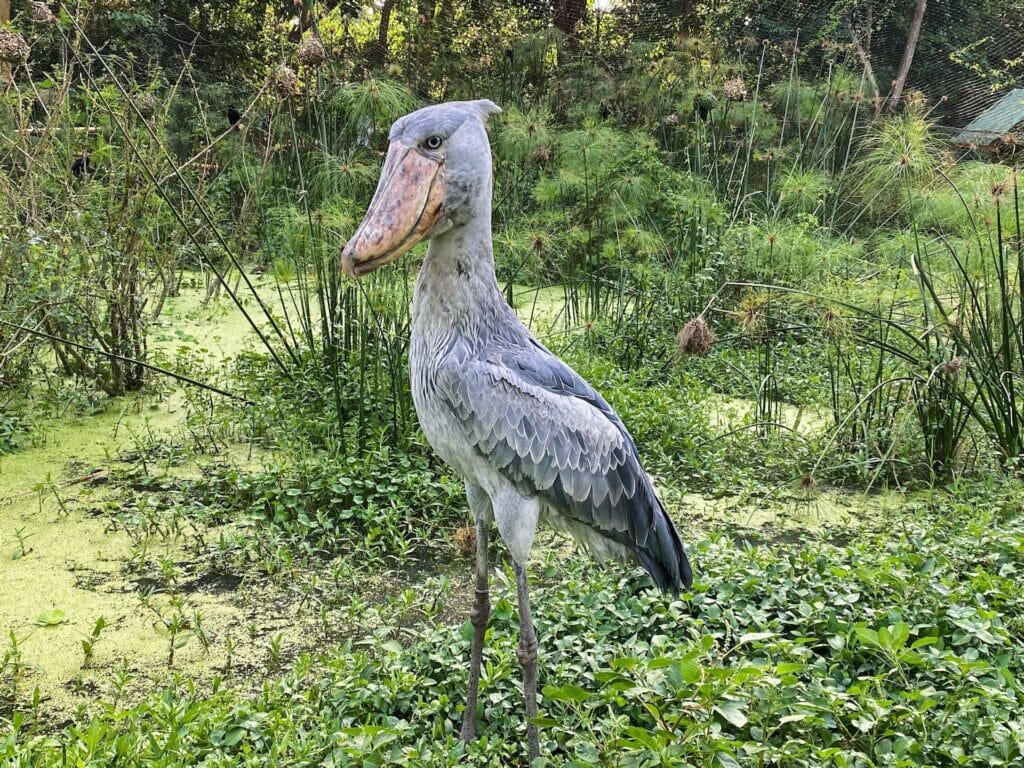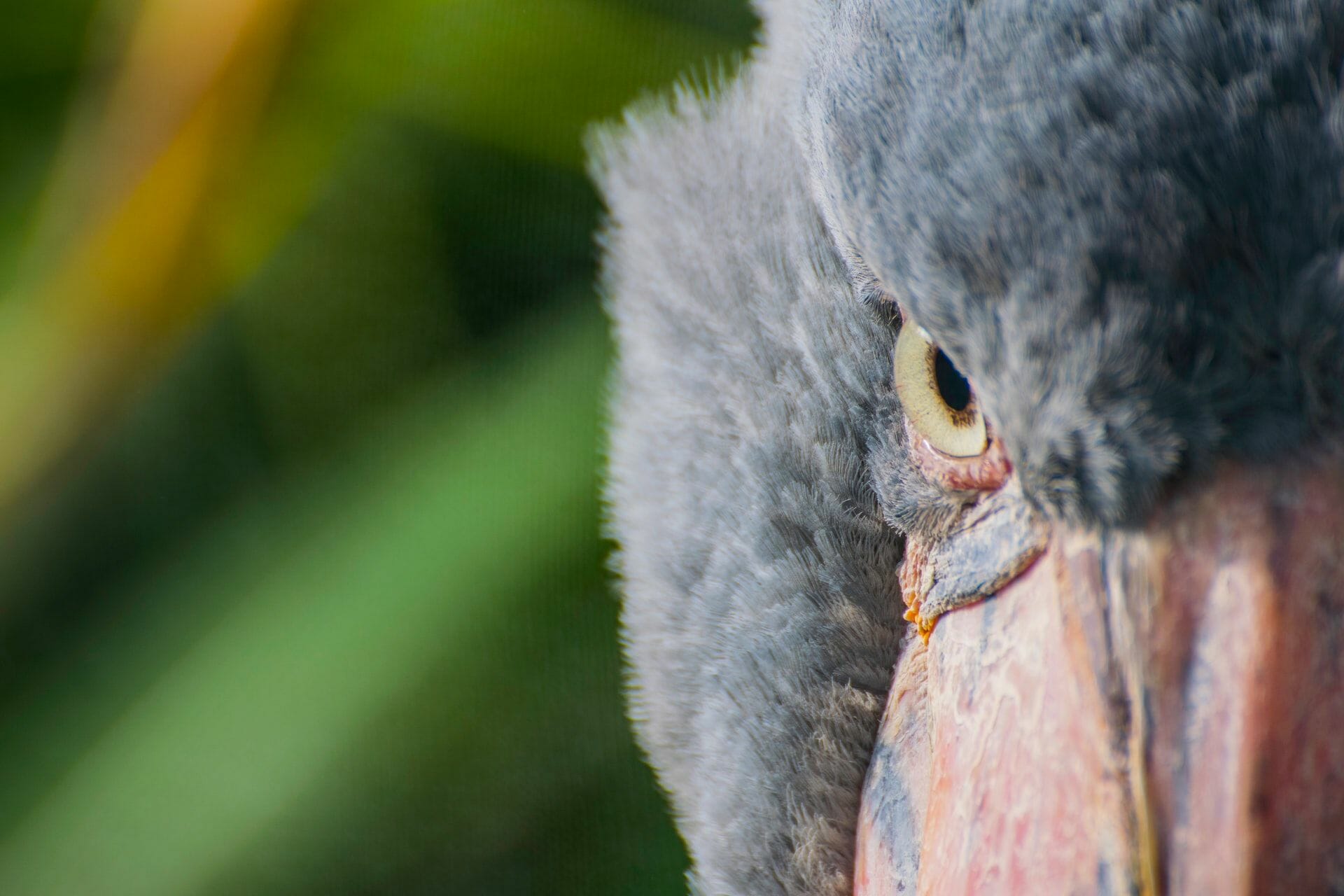Where To See Shoebill Storks + 19 Other Surprising Facts
Shoebills are one of the most fascinating birds in the world. Known as the whale bill, whale-headed stork or shoe-billed stork, this giant bird is endemic to Africa.
Because we can’t get enough of these incredible birds, we are answering all of your shoebill questions today.
Where do shoebills live?
The shoebill can be found throughout central tropical Africa and East Africa, including southern Sudan and South Sudan, parts of eastern Congo, Rwanda, Uganda, Tanzania and Zambia. If you’re looking to come to East Africa to see them, a Uganda birding safari could be a great idea!
Why do shoebills live in East Africa?
Many of these East African locations feature marshes and freshwater swamps. In these habitats, fish tend to come up for air frequently because the water is so poorly oxygenated.
As fish come up for air, they become an easy target for the shoebill. And one of the shoebill’s favorite snacks? The lungfish!
Why are shoebills sometimes called whale-headed storks?
The shoebill’s scientific name is balaeniceps rex, which means “whale-head king.” That is a reference to how its bill looks a little bit like a baleen whale.
Other fun names for the shoebill include boat-bill, bog-bird, lesser lechwe-eater, and abu markub, or “father of a slipper” in Arabic.
Is the shoebill stork actually stork?
The idea of a shoebill stork is a bit antiquated. Though once classified as storks, shoebills are now in their own family. They do have characteristics of other wading birds, like herons, and are close relatives of the pelican.
How fast can shoebills flap their wings?
It turns out that the shoebill has one of the slowest flaps of any birds at 150 flaps per minute. This is probably due to their size, with wings that can expand over 7.5 feet long and a height of up to 4.5 feet.
Those giant wings can be used to fly, balance for long periods of time, and even intimidate predators.
Why do shoebills live near hippos?
One of the fun things about seeing shoebills in Uganda and throughout East Africa is that you also often see them with hippos.
So, why is that? It turns out that because hippos end up clearing pathways through swamps when they move, shoebills can more easily navigate and nab fish. Plus, the vigorous movement of a hippo also forces those delicious fish to the surface.
Are shoebills extinct?

No, fortunately shoebills are not extinct. Still, they are endangered, with the IUCN Red List of Threatened Species sharing estimates of between 3,300 and 5,300 shoebills in the wild.
Factors threatening these fascinating birds include loss of marshlands to human threats like farming, ranching, natural resource exploration (like oil and gas), fires, poaching, and more.
What do shoebills eat?
Shoebills have a pretty wide ranging diet. They’ve been known to eat fish (those tasty lungfish again!), frogs, water snakes, snails, turtles and even baby crocodiles.
Are shoebills solitary?
Shoebills are fairly independent creatures. They tend to live by themselves, eat by themselves, and mate just a few times a year.
Even those that are mating will still hut and eat apart.
When is the shoebill mating season?
Shoebill mating season happens during the dry season. When the marshes don’t have as much water, there is less risk to newborn offspring.
Can I see shoebills on Uganda safari tours?
Many birding areas in Uganda have shoebills, including Mabamba Swamp, making Uganda one of the best places to see these rare and wonderful birds. For more information on birding in Uganda and East Africa, click here!
Do shoebills actually attack crocodiles?
The rumors are true – the shoebill can attack crocodiles. They have fought Nile crocodiles, storks, and even other shoebills.
Why do shoebills just stand there?
See the image we used for the shoebill? That may as well be a video, because shoebills are famous for standing in one place for hours. That patience is often rewarded when an unsuspecting fish pops up for air. At that moment, the shoebill lunges forward, attacks, pierces the snack, and devours it whole.
It’s all a part of their plan!
How long do shoebills live?
A shoebill can live up to 35 years.
What is a shoebill’s beak for?
That beak helps the shoebill catch and eat fish. At 24 centimeters long and 20 centimeters wide, it’s actually ¼ the size of their bodies.
This long beak helps them eat small animals in a single go, while the hook point at the end can help to pierce the prey’s body.
Are shoebills dinosaurs?
There are a bunch of creatures that are still around today that feel like they must’ve been dinosaurs. Just like crocodiles, the shoebill also has plenty of prehistoric features.
As to whether they are actually dinosaurs, the answer is no. Dinosaurs died out about 65 million years ago, and it seems the shoebill’s ancestors appeared about 35–40 million years ago.
Are shoebill storks friendly to humans?
While shoebills can be docile with humans and people have come within a few feet of their nest, it’s always good to be cautious around them. Remember, they’ve taken on crocodiles before – they know how to put up a fight!
Are there any shoebills in the United States?
While you can see a few shoebills at ZooTampa, they don’t exist in the wild in North America.
If you’re looking to see shoebills in their natural habitats, our humble (and only slightly biased!) suggestion is that you look into a Uganda safari tour. For a completely personalized itinerary, we encourage you to reach out to the expert team at Kikooko Africa Safaris today!
And if you liked these fun facts about shoebills, don’t forget to check out our facts about mountain gorillas, too!













